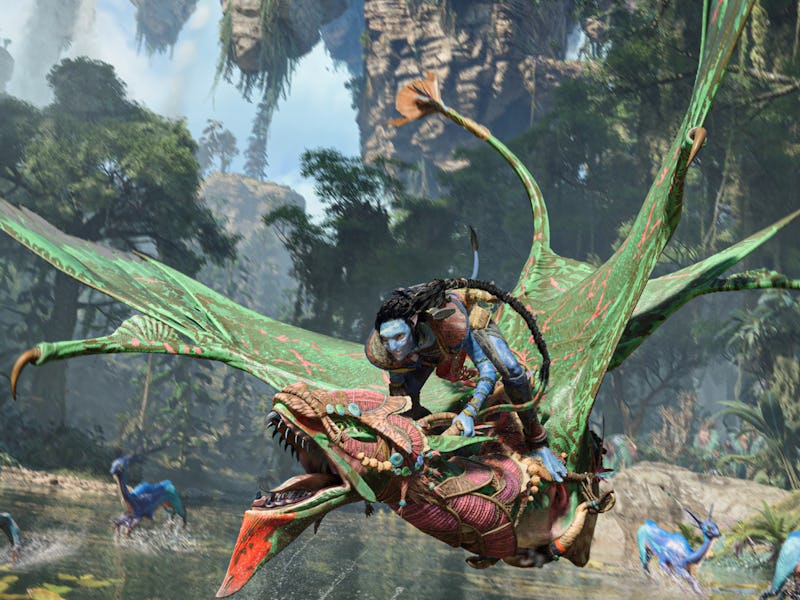Avatar: Frontiers of Pandora Crams Its Gorgeous World Into a Familiar Formula
A beautiful new world with the same old gameplay.

The greatest success of both Avatar and its 2022 sequel Avatar: The Way of Water is the world of Pandora. The visual marvel of seeing the lush alien planet on the big screen is a technical achievement so great some fans reported feeling depressed at the idea that they could never visit it.
Enter: Ubisoft’s Avatar: Frontiers of Pandora.
Having played two hours of the upcoming open-world game, one thing is clear: Pandora is once again the star of the show — and it looks incredible from the game’s first-person perspective.
When I first started playing, I could have sworn that Avatar: Frontiers of Pandora was a survival game along the lines of Ark. Plopped down in the middle of a forest on Pandora, I was tasked with collecting a heaping handful of plants for a ritual, the specifics of which I couldn’t quite parse. My menu was full of crafting recipes, and a branch on the game’s skill tree was dedicated to making those crafted items better.
Moving through the world of Avatar: Frontiers of Pandora feels great.
Gathering resources in Avatar: Frontiers of Pandora isn’t as simple as just pressing a button. Activating a gathering spot gives you a close-up view of the plant you’re trying to pick, and you need to tilt your joystick to the right angle to collect it. The first few times you pick plants, a tutorial pops up to show exactly which angle you need to hit, but after that, you’re supposed to use visual clues to figure it out yourself.
On top of that, plants have different optimal conditions they need to be picked under to raise their quality, like what time of day you harvest them. It’s a fussy system, but one that encourages you to pay more attention to the resources and be more thoughtful about how you’re collecting them, which could be a nice twist for a survival game focused on gathering.
But it turns out that’s not the kind of game Avatar: Frontiers of Pandora is. It’s much closer to Ubisoft’s other open-world first-person shooter, Far Cry.
The concluding quest of the demo comes after you get your very own “ikran” — a flying reptilian creature you can ride to soar around Pandora, which you can summon at will once you’ve bonded with it. With your ikran, you take down several flying satellite arrays set up by the RDA, Frontiers of Pandora’s invading human faction. Messing with RDA tech invites the ire of a couple of nearby helicopters, which you need to take out to continue. I can’t adequately convey my shock when I opened the game’s weapon wheel to equip my character — an at-one-with-nature blue cat person — with an assault rifle.
Avatar: Frontiers of Pandora is a much more typical FPS than it seems at first.
After you gun down a squadron of military helicopters from the back of your flying lizard, the next mission takes you further into the heart of the human encroachment. The last step of the quest requires you to sabotage a facility that’s wreaking all sorts of havoc on the local environment.
Assuming that one mostly naked assailant with a bow was no match for a facility full of soldiers in power armor, I tried the stealth approach, slowly sneaking around the outpost to take out my targets. When I was spotted, I would try to hide and take another avenue of attack, but it was never enough to shake off the army searching for me. Instead, going in guns blazing was what worked, hopping gleefully around gunfire as I struck at key components of the facility. Only after flying home to turn in the quest did I realize that Pandora is dotted with these human fortresses, there to be cleaned out and taken over just like in any other open-world shooter.
As disappointing as Avatar: Frontiers of Pandora’s turn to FPS is, there’s still something remarkable about its world. Pandora is lush to a fault, packed so densely with vegetation I couldn’t tell which plants were crafting components and which were there for show. But even in the short demo I had, I quickly started recognizing different species from the overgrown landscape. Learning where to find each resource and keeping track of how best to harvest them feels like a genuinely interesting way to spend your time in Avatar: Frontiers of Pandora.
Avatar: Frontiers of Pandora is incredibly impressive on a technical level.
The game also emphasizes finding harmony with nature in other ways. While you can hunt animals for food, they’re not just fodder. Scattered around the world are animals tagged with RDA darts, which you can remove to send the creatures scampering happily on their own. To do that, you need to pause, press a button to soothe the animal, and slowly make your way toward it.
The same system can earn you the trust of your ikran, which was my favorite part of the demo. To bond with your new flying friend, you need to follow it up a massive structure of interconnected vines and landmasses, slithering up vines and double-jumping across gaps all the way. Just moving through the world feels fantastic, whether you’re hopping along the forest floor or darting through the air on your ikran.
Whichever way you travel, Pandora is gorgeous. Even if you’re just staring into the distance at miles and miles of jungle stretched before you, Avatar: Frontiers of Pandora is every bit as impressive as the movie it’s based on at a technical level. I’m not convinced that Avatar: Frontiers of Pandora will be able to transcend Ubisoft’s typical samey maximalism, but I get the appeal of disappearing into its version of Pandora nonetheless.